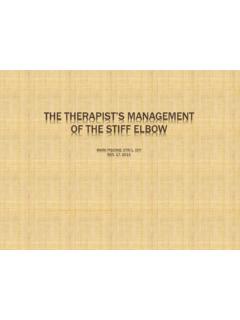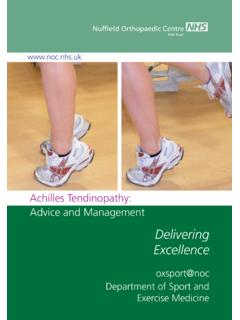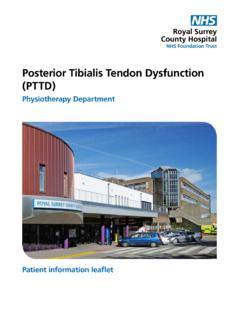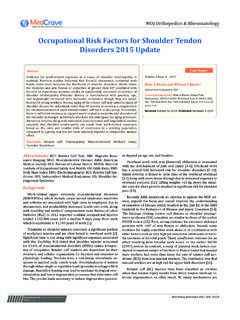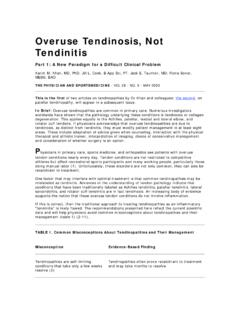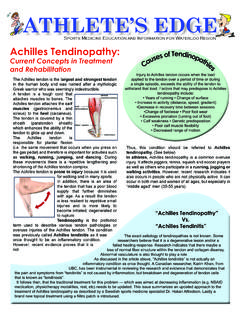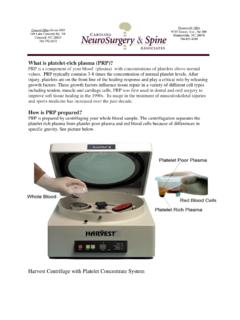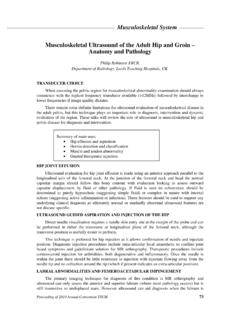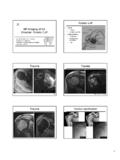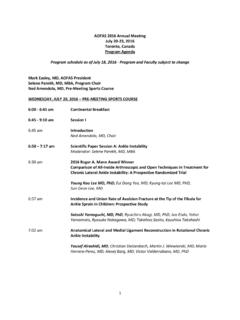Transcription of Protocols for Posterior Tibial Tendon Dysfunction ...
1 Protocols for Posterior Tibial Tendon Dysfunction &. Achilles Tendinosis Tara Bries, PT. Non-Operative Protocol for Posterior Tibialis Tendon Dysfunction Based on research by Alvarez et al. (2006) entitled Stage I and II Posterior Tibial Tendon Dysfunction Treated by a Structured Nonoperative Management Protocol: An Orthosis & Exercise Program . We were using at UIHC as early as 2003 because of Dr. Charles Saltzman who is one of the co-authors. Alvarez et al (2006). Subjects 47 (37 female, 10 male)consecutive patients with stage I. or II Posterior Tibial Tendon Dysfunction Inclusion criteria Presence of a palpable & painful Posterior Tibial Tendon , with or without swelling Movement of the Tendon with passive and active NWB clinical examination Clinical strength deficit Difficulty performing or inability to perform a single-support heel rise (SSHR) test.
2 Passively correctable deformities or no hindfoot deformity with standing Alvarez et al (2006) cont. Treatment Orthotics Short articulated ankle-foot orthosis (SAAFO): 33 patients PTT pain present for more than 3 months Unable to perform SSHR or ambulate more than one block Foot orthosis (FO): 14 patients PTT pain present for less than 3 months Able to perform at least one SSHR & could walk more than one block Switched from SAAFO to FO when their strengths were within 10-15% of contralateral side & pain had subsided. Alvarez et al (2006) cont.
3 Rehabilitation Pretreatment Phase HEP initiated consisting of sole-to sole exercises 25 reps/set, starting at 4 sets/day increasing to 12 sets by 10-14 days Once 12 sets/day reached, combine sets until could easily do 300 at one setting (taking 3-5 minutes). Phase I. Patient Education Decrease to ADLs for those unable to walk 1 block w/o pain Swimming/biking permitted Ice up to every 2 hours No whirlpools, Epsom salt baths or heat NSAIDS but no steroid injections HEP. Red t-band inversion & eversion with controlled eccentric return Begin 200 reps, 1-2 times per day Alvarez et al (2006) cont.
4 Phase II. Isokinetic workout using Cybex, Biodex or Kincom Inversion & Eversion, start at 200 reps/session, increased to 800. reps/session Heel cord stretching Gastrocnemius on slant board, 30 seconds x 3 sets SSHR. Begin with double-support-heel-rise(DSHR) & progress to SSHR. with UE for support & eccentric control down (goal 50 SSHR). BAPS board CW & CCW 5 positions w/ 20 reps each (goal 200 reps ea total). Toe Ambulation Start 25-30 feet, goal of 150 feet Progress HEP. Increase t-band resistance with goal of 200 reps with blue Alvarez et al (2006) cont.
5 Phase III. Re-evaluation with isokinetic strength eval, assessment of SSHR for 50 reps & assessment of toe walk for distance If subjective & objective progress: Phase II. continued with greater intensity for 4 more visits &. eval repeated Treatment considered to have failed if plateau reached, phase III couldn't be passed or minimal improvement was noted. These patients were offered operative treatment. Alvarez et al (2006) cont. Results 42/47 (89%)patients were satisfied with their treatment outcomes though 3 of these were classified as treatment failures d/t persistent tenderness, required bracing or had pain with toe walking 5/47 (11%) had operative reconstruction After a median of 10 PT visits during average of 4 months, most patients had minimal or no pain, could walk on tip toes, were not limited by walking distance & could perform a painless SSHR.
6 Orthotic devices generally became unnecessary as symptoms & activity approached normal. Why high-repetition exercise program? To train the muscles in an aerobic manner for long-term endurance. Low-rep with strong resistance trains muscles anaerobically which is not consistent with normal ankle function with walking. More Recent Research on PTTD. In 2009, Kulig et al published Nonsurgical Management of Posterior Tibial Tendon Dysfunction with Orthoses & Resistive Exercise: A. Randomized Controlled Trial in Physical Therapy Journal. 1st RCT reporting on effectiveness of orthoses &.
7 Tibialis Posterior Tendon -specific exercise in the management of PTTD. Kulig et al (2009) cont. 36 adults with stage I or II PTTD were randomly assigned to 1 of 3 groups Orthoses wear & stretching (O group). Orthoses wear, stretching & concentric PRE (OC group). Orthoses wear, stretching & eccentric PRE (OE group). Pre & Post intervention data were collected Foot Functional Index Distance traveled in 5-Minute Walk Test Pain immediately after 5-Minute Walk Test Kulig et al (2009) cont. Results Foot Functional Index scores (total, pain & disability).
8 Decreased in all groups after the intervention OE group demonstrated the most improvements in each subcategory O group demonstrated least improvement Pain immediately after the 5-Minute Walk Test was significantly reduced across all groups after the intervention. Kulig et al (2009) cont. Conclusion People with Stage I & II PTTD benefited from a program of orthoses wear & stretching Eccentric & Concentric exercises further reduced pain &. improved perceptions of function OE group tolerated greater loading after intervention Limitation They used an exercise device (TibPost Loader) for OC &.
9 OE groups that resisted horizontal foot adduction Kulig TibPost Loader Eccentric Strengthening for Chronic Achilles Tendinosis Protocol that I've been using since I was at UIHC was based on the Alfredson et al, (1998) study out of Sweden This appears to be one of the 1st controlled studies on eccentric calf muscle training in patients with Achilles tendinopathies. Based on resent studies (2013 & 2014), they are still using Alfredson's study as the gold standard that other Protocols are being tested against. Alfredson et al (1998). Subjects 30 recreational runners with pain preventing running Chronic Achilles Tendinosis (2-6 cm above insertion).
10 Failed conventional treatment (rest, NSAIDs, changes in footwear/orthoses, PT & ordinary training programs . All selected for surgical treatment, but 15 underwent eccentric calf muscle training program while waiting for surgery. Alfredson et al (1998) cont. Group 1: 15 patients (12 men, 3 women). Age +/- 7 yrs 12 wk heavy load eccentric program Group 2: 15 patients (11 men, 4 women). Age +/- yrs Treated surgically This group had longer duration of symptoms only because waiting time for surgery at their clinic was 6-12 months Alfredson et al (1998) cont.)
